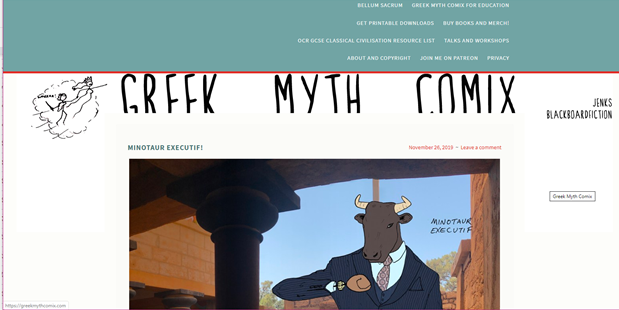Title of the resource
Title of the resource in english
Original language
Target and Age Group
Teachers, students, Greek myth lovers, general public
Link to resource
Author of the Entry:
Marta Pszczolińska, University of Warsaw, m.pszczolinska@al.uw.edu.pl
Peer-reviewer of the Entry:
Elżbieta Olechowska, University of Warsaw, elzbieta.olechowska@gmail.com
Second Peer-reviewer of the Entry:
Ayelet Peer, Bar- Ilan University, ayelet.peer@biu.ac.il
Laura Jenkinson-Brown
Laura Jenkinson-Brown is an ex-bookseller and teacher of Classical Civilisation, Ancient History, and, earlier, teacher and examiner of English Literature.
Originally from London, she lives with her husband in the literary city of Portsmouth on the South coast of England. Having dabbled in web design, fiction and self-publishing, she now devotes all her spare time to drawing mythical and educational comics; she started doing that to illustrate Greek myths and literary concepts in Homeric epic to help her students visualise what they were learning. Her work is now used worldwide by schools, universities, and individuals.
She also does mythological and archaeological illustrations for CSCP (Cambridge Schools Classics Project) and collaborates on Classics-themed projects, occasionally doing workshops around the country at schools and conferences, including for Classics For All.
Publications and Projects:
● How To Write Essays - a Student Guide
● The Odyssey Graphic Revision Guide - books 5,6,7,9,10,12
● The Odyssey - Book 1, 19
● Build-Your-Own Trojan War Kit
● The Olympians Colouring Book
● The Life of Heracles (wip)
● Myth Storyboards (assorted) - for CSCP (KS3)
● The Bar of Amarantus and his Neighbours - for CSCP (full book illustrations, for KS3, KS4) (wip)
source: The Author
Questionnaire
1. Could you describe your experiences in education with Classical Antiquity? Do you base your works on experiences with teaching children, youth or students? Why? Who and where have you taught?
I base my work on my experiences teaching pupils in secondary schools, and design my comics as resources to be used in education. I have been a teacher for 14 years in the Secondary state and private systems, although my work has been used in Universities and Primary schools around the world.
2. What are the language teaching methods and approaches of your choice (e.g. traditional translation-grammar/direct/audiolingual methods, humanistic approach, communicative approach) and why? How/Do they differ depending on your works and target groups? Do you focus on receptive or productive skills and why?
My work uses English as I’m interested in simplifying or explaining the ideas behind myths, Homeric literature, and technical terms, and my students have English as their main language. However, I am very interested in communicating the etymology of ancient languages, and in those cases I use a direct translation or transliteration method.
3. How do you select the myths and cultural material to be incorporated in your works and how do you present them (do you strive for accuracy, with the cultural background of Antiquity, or do you rather contemporize their form, content or background to be relevant to the target group?)
I started choosing my topics by letting my students decide on what aspects of literature or myth they would like explained. However, I also jot down ideas as I come to them in my teaching, and come back to them later. With my comics, I always strive for accuracy, referring to the original texts (albeit in translation), scholarly writing about them, and comparisons of details between writers who have tackled the topic before me, although I simplify the visual details. With my illustrations I take more of an archaeological approach, researching plans, specifications, finds, and consulting with archaeologists and experts.
4. How and why do you choose the style of your illustrations that accompany the teaching material (e.g. focus on factual accuracy, attractive form for the reader or contemporizing the illustrations?)
With my comics, I use a simplified style for both figures and backgrounds, as they are there just to set a scene: the detail of the story or topic is more important. My simplified style is based on stick-men, which are universally understood by people of all ages. With my illustrations and archaeological drawings, the figures remain simplified, albeit a bit more fleshed out and with detailed clothing and accessories based on archaeological details, but the backgrounds are researched in great detail in order to give the most realistic and accurate setting. In all my illustrations, facial features are missing, the figures instead relying on body language to communicate, as this is the most recognisable method of communication, especially for children, and does not exclude those who find it difficult to navigate facial expression.
5. Have you encountered any challenges in creating material on Ancient (and thusly extinct) languages and culture and why do you think is important to popularize them?
Despite expecting challenges when illustrating and explaining mythology and literature that are extremely popular and subject to the scrutiny of academics, other teachers, and the wider media, I have found my work to be - somewhat surprisingly – pretty universally popular. That’s also literally – I have had visits to the website where I store my resources from all over the world. I do not create my work in order to popularize the topics the feature in it, as that’s not necessary. What is necessary is to popularise the actual details, the correct versions, and make it clear that these are not just for academics – children and pupils don’t need completely simplified versions of stories, or versions where myths are changed to suit the author’s interests. They aren’t my myths to change.
Prepared by Marta Pszczolińska, University of Warsaw (m.pszczolinska@al.uw.edu.pl).
Contents & Purpose
The website is focused on presenting students with ancient myths in an approachable and entertaining form of a comic. The author of the comics reaches for absolute classics: myths, the Odyssey, drama, the Aeneid, and allows the reader to effortlessly learn numerous interesting facts and concepts from mythology, literature, philology, philosophy and other sciences.
Greek Myth Comix was originally launched to assist students in the author’s Classics KS4 and KS5 classes to understand the concepts behind the Homeric epics and Greek pantheon. That is why amongst the heroes of the comics figures also Homer at the beginning (see below) and Homeric heroes in scenes from the Odyssey from books 1, 5, 6, 7, 9, 10, 12 (see below). The presentation of the scenes from the myth is not everything, however, as the user can also find additional philological and cultural commentary (e.g. What Makes a Homeric Hero - see below). The Trojan motifs were also supplemented by additional resources regarding other mythical events not described by Homer. Besides the comics, the user can also access a set of the Trojan War playing cards and the Trojan War Paper Doll Playset. The playset contains the walls of Troy (Skaian Gates), the Greek Camp, Achilles’ hut, Trojan Horse, Achaeans and Trojan soldiers and women who act scenes of the Trojan War.
In addition to the Homeric motifs, the author also introduces comics with Theseus, Heracles and other characters, such as the famous teacher of heroes Cheiron the centaur (see below). The author also directs the young reader to recognise ancient motifs in the Harry Potter series.
A strong advantage of the website is that also provides printable downloads, which can become useful during class. For the younger readers, the learning can be enriched by the introduction of fun activities such as the Olympian gods colouring book. Anyone can also enjoy the accounts of the author’s Mediterranean travels in the form of a comic.
The website also offers a set of playing cards for the card game Bellum Sacrum illustrated by the author in cooperation with Anthony Gibbins of Legonium, which can be used for a card game based on a duel between Greek gods equipped with their attributes and characteristics.
greekmythcomix.com/bellum-sacrum,
kickstarter.com/bellum-sacrum (accessed: November 16, 2019)
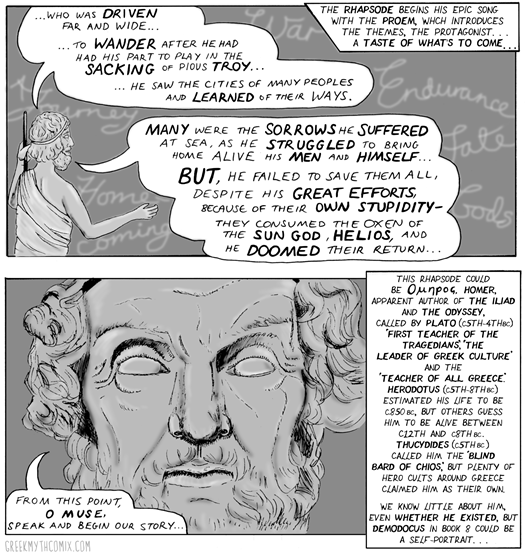
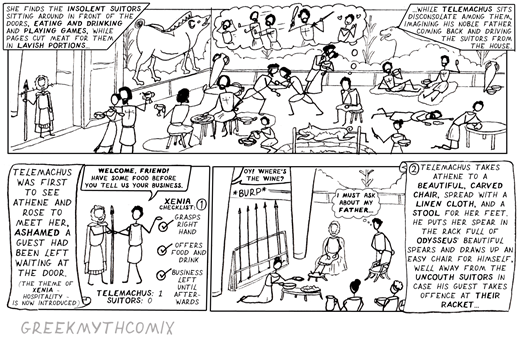
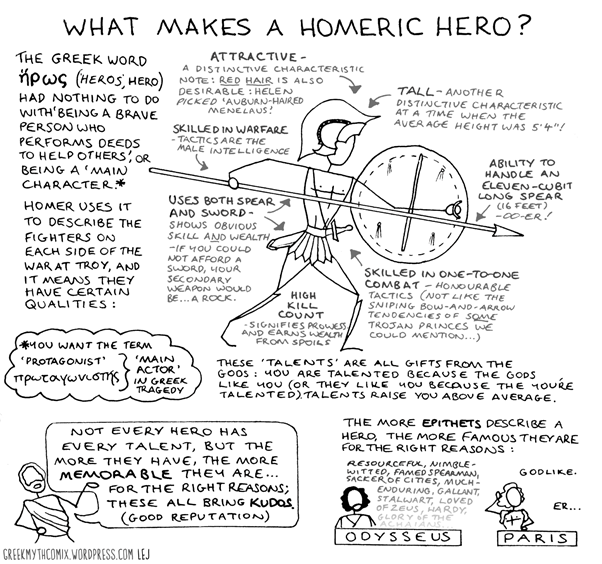
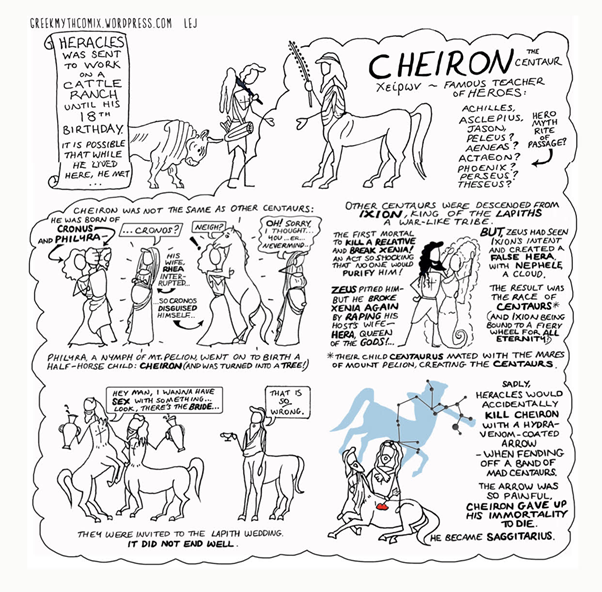
Pictures courtesy of the author

